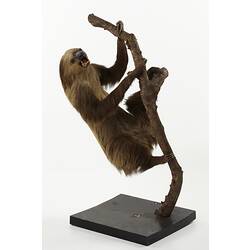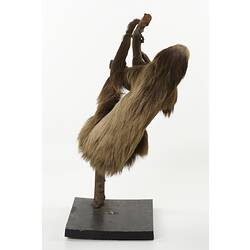Summary
The Southern Two-toed Sloth, also known as Linnaeus's Two-toed Sloth, is one of two species of two-toed sloth. They occur in tropical lowland and montane forest in the north of South America.
This specimen came from French Guiana. It was purchased purchased from the French naturalist, explorer and natural history dealer J P Verreaux in 1867.
Two-toed sloths spend most of their lives hanging upside-down in trees. They are extremely slow moving and mostly eat leaves and other plant material which they ferment in their many-chambered stomachs.
Despite their name, two-toed sloths actually have three toes on their feet but have two fingers on their hands, meaning their name should more accurately be "two-fingered sloths". The number of fingers is a major distinguishing characteristic between the two-toed and three-toed (or fingered) sloths which have a similar range and lifestyle.
Southern Two-toed Sloths are not usually a target for hunters as they occur high in the forest canopy and are very difficult to see. There do not appear to be any major threats to the Southern Two-toed Sloth and populations seem to be stable. The International Union for Conservation of Nature (IUCN) therefore lists them as being of Least Concern.
Specimen Details
-
Taxon Name
-
Preferred Common name
Linnaeus's Two-toed Sloth
-
Other Common Names
Southern Two-toed Sloth
-
Number Of Specimens
1
-
Sex
Unknown
-
Specimen Nature
Nature: Mount, Form: Dry
-
Collected By
Unknown
-
Category
-
Scientific Group
-
Discipline
-
Collecting Areas
-
Type of Item
Taxonomy
-
Kingdom
-
Phylum
-
Subphylum
-
Class
-
Superorder
-
Order
-
Suborder
-
Family
-
Genus
-
Species Name
didactylus
Geospatial Information
-
Country
-
Precise Location
Cayenne






